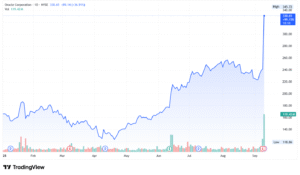AI Insights
George Osborne says UK has been left behind in cryptocurrency boom | Cryptocurrencies

The UK has been left behind in the cryptocurrency boom and is in danger of missing a second wave of demand, according to the former chancellor George Osborne.
Osborne, who has an advisory role at the crypto exchange firm Coinbase, said the country already missed out on the first generation of crypto because the formerly sceptical US had embraced digital currencies under Donald Trump.
“What I see makes me anxious. Far from being an early adopter, we have allowed ourselves to be left behind,” wrote Osborne in a Financial Times opinion piece.
Osborne said the UK was now about to miss a new surge in the crypto market: stablecoins.
Unlike bitcoin, which is prone to extreme fluctuations in price, stablecoins are digital currencies pegged to the value of real-world currencies such as the dollar – and thus designed to maintain a stable value. However, a leading stablecoin, TerraUSD, collapsed in 2022.
“If Britain was the only financial centre in the world we could take our time to evaluate how stablecoins will develop, but we are not,” wrote Osborne. “Singapore, Hong Kong and Abu Dhabi have adopted comprehensive legislative frameworks for crypto asset platforms.”
Osborne also pointed to the passing of the US Genius Act, which creates a regulatory regime for stablecoins – the majority of which are now dollar-backed.
“The crypto revolution may have started with plans to replace the dollar as the world’s reserve currency, but it is reinforcing its dominance. Britain’s current approach ensures the pound won’t even play a supporting role,” Osborne wrote.
US citizens can buy a bitcoin exchange traded fund – a basket of assets that can be bought and sold like shares on an exchange – whereas in the UK retail investors cannot do so.
Osborne accused the UK of prevaricating over stablecoins, with the current chancellor, Rachel Reeves, showing insufficient commitment with a promise last month to “drive forward” on stablecoins, while the Bank of England remained sceptical.
In a speech last month, the Bank of England governor, Andrew Bailey, called for the development of standards that show whether stablecoins pass the test of “singleness of money” – or whether a stablecoin can be exchanged with another form of money one-for-one.
“This hesitation risks irrelevance,” wrote Osborne, who added that it was time for the UK to “catch up”.
Other crypto advocates from the era of the 2010-15 Conservative-led coalition government include another former chancellor, Philip Hammond, who is chair of the crypto firm Copper.
A Treasury spokesperson said the government’s economic strategy was combining support for innovation with safety for consumers.
“Robust rules around crypto will boost investor confidence, support the growth of fintech and protect people across the UK,” the spokesperson said.
AI Insights
Dick Yarbrough: A semi-intelligent look at artificial intelligence

Dick Yarbrough
Syndicated columnist
Dr. Geoffrey Hinton is a British-Canadian cognitive psychologist and computer scientist who won the Nobel Prize in Physics last year “for foundational discoveries and inventions that enable machine learning with artificial neural networks.” Between you and me, I got hosed. I should have been a winner.
The Nobel committee obviously overlooked my own entry entitled, “One molecule of glucose bound to one molecule of fructose will make sugar and winning the Nobel Prize sure would be sweet.” I don’t think they know a lot about physics over there in Norway.
Just as I am known as a modest yet much-beloved columnist who bears an uncanny resemblance to a young Brad Pitt, Dr.
Hinton, who looks nothing like Brad Pitt, young or old, is considered the Godfather of Artificial Intelligence. That’s like being Godfather of the Mafia. Only worse.
If somebody in the Mafia got out of hand, you would just shoot them or put them in a tub of concrete and deposit them in the East River. According to Dr. Hinton, artificial intelligence is likely to get rid of anybody left in the Mafia and the rest of us as well, and it won’t need a gun or a sack of concrete to do it.
“It’s not inconceivable,” he has stated, “that artificial intelligence could wipe out humanity,” saying that there was a “10 to 20 percent chance” that AI would be the cause of human extinction within the following three decades. In fact, many experts expect AI to advance, probably in the next 20 years, to be “smarter than people.”
Admittedly, I am not the go-to person on the subjects of cognitive psychology and computer science (although knowing how sugar is made is pretty impressive), but I would posit that it is not going to take 20 years for artificial intelligence to get smarter than people.
That’s already occurred in some instances. Just look at Congress.
Can you see a computer saying, “Beep! Beep!
Hey, I want to suck up to Donald Trump. I think I will propose changing the name of Greenland to Red, White and Blueland and then he will get me elected to the Senate where I can do other dumb stuff. Boop!” There are some things a computer won’t do, even if a member of Congress will.
Dr. Hinton also worries about the impact of AI on religion. He says, “I think religion will be in trouble if we create other beings. Once we start creating beings that can think for themselves and do things for themselves, maybe even have bodies if they’re robots, we may start realizing we’re less special than we thought.
And the idea that we’re very special and we were made in the image of God, that idea may go out the window.” An interesting observation.
Theologically speaking, if computers become robots, will there be girl robots and boy robots?
If so, will boy robots let girl robots in the pulpit?
Or will the boy robots tell other robots that if they think girl robots should be allowed to preach, they will be condemned to spend eternity in an electronic waste disposal bin at Best Buys?
As to whether or not we are made in the image of God, I believe that’s God’s call, not mine. Creation is His thing. I will say that had God asked me, there are a few people He created that I think we could just as soon done without. I couldn’t find His image in them with a flashlight. Maybe He just put them here to show us He has a sense of humor.
I probably won’t be around to see how all this plays out, but despite the Godfather of AI’s ominous warning, no robot will ever make me feel less special. I’ve got a family that loves me more than I deserve. I have friends that have stood with me through the good times and the bad. I had a rewarding career. I am blessed to live in this special state in this special country.
Most of all, thanks to a benevolent editor willing overlook misplaced commas and grammatical errors (Is it who or whom?), I have the opportunity to share my thoughts with you each week and to receive your feedback. That may come in the form of a kudo or a rap on the knuckles. I suspect robots won’t give a flying algorithm for you or your opinions. I do.
And there is nothing artificial about that.
You can reach Dick Yarbrough at dick@dickyarbrough. com or at P.O. Box 725373, Atlanta, Georgia 31139.
AI Insights
Oracle (ORCL) Stock Soars 40% on AI Boom and $455B Cloud Backlog While Going Green

Oracle Corporation (NASDAQ: ORCL) surprised the markets today with a dramatic stock rally. Its shares jumped more than 40%, reaching record highs and placing the company near the trillion-dollar club. This sharp increase was powered by huge demand for Oracle’s cloud services, especially for artificial intelligence (AI) and big partnerships.
Wall Street focused on the financial side, but Oracle also highlighted something else: its environmental goals. The company wants to show that fast growth can go hand in hand with sustainability. By investing in both AI and green programs, Oracle is shaping an image as a modern tech leader that balances profit with responsibility.
Record-Breaking Rally: Oracle’s Biggest Jump in Decades
The jump in Oracle’s stock was its largest in more than 30 years. Investors reacted to news that Oracle signed multiple multi-billion-dollar contracts with tech giants such as OpenAI, Meta, and NVIDIA.
These contracts are tied to AI cloud services and pushed Oracle’s contract backlog to around $455 billion, a sharp rise from $130 billion just a quarter earlier.

This backlog shows how fast demand for Oracle Cloud Infrastructure (OCI) is growing. The company responded by raising its forecast for OCI revenue. It now expects 77% growth this fiscal year, higher than its earlier estimate of 70%. The company also predicts $18 billion in cloud revenue in 2025 and has set a long-term target of $144 billion by 2030.
The growth reflects the global rush to build AI systems. Oracle has placed itself at the center of this movement, partnering in major projects such as the Stargate initiative led by SoftBank and OpenAI. These deals highlight Oracle’s role in powering the next generation of AI.
Recent Developments Strengthening Oracle’s Position
On top of these strong results, Oracle has made headlines with two new announcements that underline its growing role in AI.
The first is a massive deal with OpenAI. Beginning in 2027, OpenAI will purchase at least $300 billion worth of computing power from Oracle over five years. This is one of the largest cloud agreements in history, and it shows how central Oracle has become to advanced AI systems. For Oracle, it marks a major vote of confidence from one of the most important AI companies in the world.
Oracle’s stock surged to a record high. This boosted the company’s market value to nearly $1 trillion. The rally also made headlines for another reason: it boosted co-founder Larry Ellison’s wealth by more than $100 billion in a single day, making him the world’s richest person.
Greener Growth: Oracle’s Path to Net Zero
Amid the AI excitement and stock rally, Oracle is pushing its green message. The company has promised to be carbon neutral by 2050. It also set a nearer goal to cut greenhouse gas emissions in half by 2030, using 2020 as its baseline year. These goals cover its offices, data centers, and cloud services.



Oracle has already achieved some key milestones:
- Renewable power: 86% of OCI’s global energy came from renewables in 2023.
- Regional progress: Europe and Latin America already run on 100% renewable power.
- Global ambition: Oracle plans to hit 100% renewable energy worldwide by 2025.
- Water and waste: Since 2020, water use has dropped by almost 25% and landfill waste by more than 35%.
- Travel impact: Employee air travel emissions have been cut by 38% thanks to more virtual meetings.
These achievements prove Oracle is not only talking about sustainability but also acting on it. For a company scaling up fast in cloud and AI, these steps are important. They show Oracle is trying to balance expansion with its responsibility to the planet.
Pushing Green Standards Across the Supply Chain
Oracle knows its environmental impact extends beyond its own walls. A big part of its footprint comes from suppliers. That’s why the company is pushing its partners to meet strict environmental standards.



Here are some of the key steps:
- Supplier programs: All major suppliers must have environmental programs.
- Emission targets: At least 80% of suppliers are expected to set formal climate goals.
- Progress: More than four in five suppliers already meet these expectations.
- Broader impact: By setting these standards, Oracle ensures its ESG efforts reach across its global supply chain.
This approach boosts Oracle’s credibility. It tells investors and clients that the company’s sustainability commitments are not limited to its own operations. Instead, they cover the full ecosystem of partners that make its technology possible.
AI-Powered Tools for Climate Accountability
Oracle is also building tools to help other companies meet their climate goals. One of these is Fusion Cloud Enterprise Performance Management (EPM) for ESG. This platform allows organizations to automate sustainability reporting, integrate emissions data with financial information, and align with global standards.
The system uses AI to make reporting easier and more accurate. This is important as regulators push companies to disclose their environmental impacts in more detail.
-
It combines Scope 1, 2, and 3 emissions data based on the GHG Protocol Corporate Standard. This links emissions to financial and operational data, helping with better ESG management.
-
Oracle improved its ESG reporting with this platform. They cut reporting timelines by 30% using automation and AI-driven process management.
-
The platform collects unique identifiers from source documents. This ensures clear data tracking and auditability. It boosts transparency and lowers compliance risks.
-
It supports global reporting standards like IFRS, ESRS (CSRD), and GRI. This helps organizations align their disclosures with changing regulations easily.
Oracle has also introduced features in its cloud infrastructure that estimate emissions from customer workloads. This means clients can see how much carbon their computing generates and adjust operations to stay on track with their own sustainability commitments. By doing this, Oracle is not only greening its own business but also helping others.
The Tough Road Ahead: Energy Demands vs. Climate Goals
Still, Oracle faces challenges in meeting its promises. Reaching 100% renewable energy worldwide is difficult, especially in regions where clean energy options are limited. Ensuring suppliers stick to emissions goals is also complex, given the size of Oracle’s global network.
Another challenge is the massive energy demand of AI. As Oracle expands its role in AI infrastructure, its energy use will rise. Balancing this growth with its climate goals will require new investment in efficient data centers, renewable sourcing, and innovations in green computing.
Oracle’s record-breaking stock surge highlights its importance in the AI and cloud industry. But what makes its story more powerful is the balance it is trying to strike between growth and sustainability. By pledging net zero emissions by 2050, setting ambitious near-term targets, and building tools for others to track emissions, Oracle is showing that technology and responsibility can go together.
For investors, Oracle now offers both a high-growth AI story and a strong ESG narrative. For customers, it provides powerful cloud services backed by renewable energy and transparent carbon data.
As Oracle continues to grow, its ability to deliver on both financial and environmental goals may define its future as one of the world’s most influential technology leaders.
AI Insights
Loneliness Is Reshaping Your Workplace

As a seasoned senior vice president at a global tech firm, Sharon wasn’t expecting to feel emotional while listening to a keynote. But as former U.S. Surgeon General Dr. Vivek Murthy spoke, describing how loneliness has become a public health crisis, something clicked. “It wasn’t that the information was new,” she told us. “It was that I suddenly saw the evidence everywhere—in my team, in our culture, even in myself.”
-

 Business2 weeks ago
Business2 weeks agoThe Guardian view on Trump and the Fed: independence is no substitute for accountability | Editorial
-
Tools & Platforms1 month ago
Building Trust in Military AI Starts with Opening the Black Box – War on the Rocks
-

 Ethics & Policy2 months ago
Ethics & Policy2 months agoSDAIA Supports Saudi Arabia’s Leadership in Shaping Global AI Ethics, Policy, and Research – وكالة الأنباء السعودية
-

 Events & Conferences4 months ago
Events & Conferences4 months agoJourney to 1000 models: Scaling Instagram’s recommendation system
-

 Jobs & Careers2 months ago
Jobs & Careers2 months agoMumbai-based Perplexity Alternative Has 60k+ Users Without Funding
-

 Podcasts & Talks2 months ago
Podcasts & Talks2 months agoHappy 4th of July! 🎆 Made with Veo 3 in Gemini
-

 Education2 months ago
Education2 months agoMacron says UK and France have duty to tackle illegal migration ‘with humanity, solidarity and firmness’ – UK politics live | Politics
-

 Education2 months ago
Education2 months agoVEX Robotics launches AI-powered classroom robotics system
-

 Funding & Business2 months ago
Funding & Business2 months agoKayak and Expedia race to build AI travel agents that turn social posts into itineraries
-

 Podcasts & Talks2 months ago
Podcasts & Talks2 months agoOpenAI 🤝 @teamganassi

